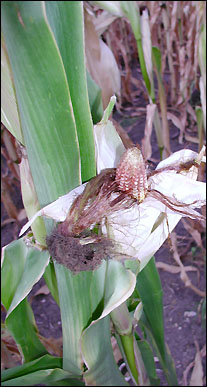Drought conditions continue to plague farmers
 Last week, the United States Department of Agriculture officially identified central Minnesota as an area suffering from a moderate drought, which was not news to area farmers, who began expressing concern weeks ago when their crops began to dry out.
Last week, the United States Department of Agriculture officially identified central Minnesota as an area suffering from a moderate drought, which was not news to area farmers, who began expressing concern weeks ago when their crops began to dry out.Because of a stubborn weather pattern that has settled over the region, central Minnesota hasn't had any significant rainfall since July 4, and crops Ð particularly corn and soybeans in the Paynesville area Ð are suffering from the lack of moisture, said Glen Young, a weather forecaster in Litchfield.
According to the Minnesota Agricultural Statistics Service, crop conditions throughout the state have declined as soil moisture levels dried throughout August. In their most recent survey, Minnesota farmers rated only 57 percent of their corn crop as excellent, down from 75 percent in early August. Fifty percent of Minnesota farmers now rate their soybean crop as excellent, compared to 66 percent three weeks ago.
According to the survey, 28 percent of the state's fields were considered to be very short in moisture and 52 percent short. Only 20 percent of fields statewide had moisture levels that were considered adequate for crops.
John VanderBeek of Paynesville Farmer's Union said he hasn't seen weather conditions this dry since 1988.
The leaves of some corn plants in the Paynesville area have started to furl. Once this happens, there is a yield loss of about two percent per day, said Dave Schwartz, a Meeker County Extension Educator.
And some corn in the Paynesville area has deteriorated well beyond curled leaves. Some of the crop is completely dry and looks similar to fields that are ready to harvest, but it isn't, said Schwartz. In fact, the ears on the stricken plants are not full and the kernels aren't as large as they should be, he said.
In an effort to salvage whatever they can, farmers have started to chop corn for silage, which is what Schwartz recommends. Even farmers who didn't intend to use their corn in this way are chopping, but Schwartz warns that some corn, especially in low, sandy areas is already too dry to chop. This corn, according to VanderBeek, is "junk."
Gladys Orbeck Ð who farms near St. Martin with her sons Bob and Kevin Ð started chopping silage last week and continues to rotate between chopping and bailing hay through this week. She said that corn in the low areas is really dry, but there are a few small ears on some of the crop. They didn't intend to use their whole corn crop for silage, but according to Gladys, it will be put to use and will be OK for forage.
Ideally, according to Schwartz, silage corn should have a moisture level of 60-65 percent. If it's too wet or too dry, it doesn't keep well in silos and may be unappealing to livestock.
Even corn that has proper moisture levels for storage may not be nutritionally adequate he cautioned, since most of the plant's nutritional value is in the grain Ð which never fully developed in some cases.
Soybeans can withstand more heat and dry weather than corn, but even area soybeans are showing stress, said VanderBeek.
Soybean plants respond to drought conditions by forming smaller beans or by aborting beans.
Some area farmers Ð including Jim Hartmann, who farms near Paynesville with his brother, Bub Ð have already begun to consider their bean crop lost. The Hartmanns' fields were hit hard by soybean aphids, but they chose not to spray the crops because they figured dry weather would kill the plants before the aphids did.
Hartmann knows their fields are in bad shape. Some of the high ground is completely gone, he said, but he can't bring himself to visit the fields that are still green to assess the damage. "It's so sad. I don't even want to see it," he said. He's been told that even in the fields that are still green, there are no beans in the pods. "Farming is a gamble," said Hartmann.
Orbeck agrees that between the aphids and the weather her family's beans will likely be lost also. Unlike corn, which can be used for silage, there are no uses for soybeans damaged by drought. She's trying to keep her sense of humor about the situation, however. "We're serving baked aphids with roasted beans," she laughed. Ronald Thorson, who farms near Hawick, is fortunate to have irrigation for some of his crop so he won't suffer a complete crop loss, but irrigators don't reach everything. Even before the soil began to dry out, Thorson had problems with soybean aphids and leafhoppers in his alfalfa, making it a rough season.
Market prices have begun to reflect the weather. According to Schwartz, in anticipation of low corn and soybean yields, market prices for both crops have steadily risen since last month Ð a fact that is little comfort to those who may not have a crop to harvest.
According to Young, there is a slight chance of rain this week, but it will be spotty and may not hit our area. A tropical storm, brewing in the Gulf of Mexico, may help push some precipitation into the area but not until late in the week.
Contact the author at editor@paynesvillepress.com • Return to News Menu
Home | Marketplace | Community